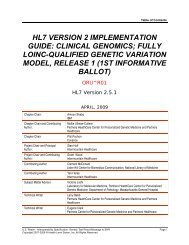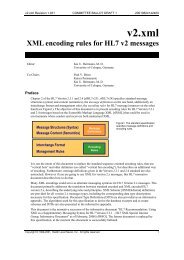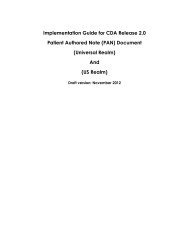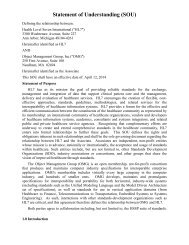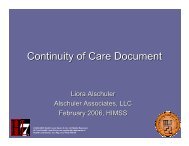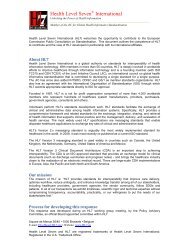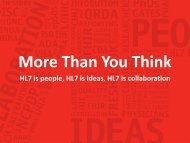HL7 CDA R2 AIS Implementation Guide
HL7 CDA R2 AIS Implementation Guide
HL7 CDA R2 AIS Implementation Guide
You also want an ePaper? Increase the reach of your titles
YUMPU automatically turns print PDFs into web optimized ePapers that Google loves.
<strong>HL7</strong> Additional Information Specification <strong>Implementation</strong> <strong>Guide</strong><strong>CDA</strong><strong>R2</strong><strong>AIS</strong>0000R030Note on the element. The element has a @value attribute that containsa URL that points to the content being referenced. This element is used in several places withinthe <strong>CDA</strong> Release 2.0 specification to provide a mechanism to refer to external content. Absentspecific specifications in an Additional Information Specification, two different types of URLreferences are permitted:1. Reference to content contained within the same MIME multipart document that contains the <strong>CDA</strong>document shall use a relative URL that begins with the Content-ID of the component of the MIMEmultipart document that is being referenced.2. References to content contained elsewhere (e.g., via a web server or other connection) shall use anabsolute URL that contains the complete path to the document being referenced.These restrictions are designed to reduce the complexity of a receiver's implementations ofattachments.Issues with the Use of External References. When external references are used the mechanismfor ensuring the confidentiality of the information in the external file and establishing theauthority of the receiver to view the information must be established between trading partnersrather than by this specification.When external references are used, the receiver of the <strong>CDA</strong> document should consider whethersimply keeping the URL of the multimedia image file constitutes an adequate audit trail. Thatdecision is outside the scope of this specification and may be dependent on the particular sourceof the multimedia file (e.g., some specific organizations that serve as a repository for images maybe trusted in this regard).Because of the additional responsibilities of the receiver when multimedia files are referencedwith a URL the default in Additional Information Specifications is to require that the multimediafiles be included with the <strong>CDA</strong> document. However, this <strong>Implementation</strong> <strong>Guide</strong> includeslanguage to allow specific Additional Information Specifications to permit references tomultimedia files that are not sent with the <strong>CDA</strong> document.Types of Multimedia Files. There are many forms of multimedia files identified in variousInternet standards. Absent specific specifications in an Additional Information Specification thesender is limited to static visual image formats commonly rendered by browsers (see Table3.5-1). This restriction is designed to reduce the complexity of a receiver's implementations ofattachments. In future Additional Information Specifications the industry may agree to othermultimedia types (such as DICOM) for specific use cases.3.7 Representation of Data TypesIn the "computer-decision" variant of an attachment document, answers must be encoded in aformat that can be reliably interpreted by a computer. (See Table 3.6-2 for a list of the commonlyused data types for this purpose.) At the same time, all answers must be capable of beinginterpreted by a human being. An XML stylesheet, in conjunction with a commonly availablebrowser, enables rendering of the structured information in both the header and body for humanviewing. One or more stylesheet files are included in the set of supplemental files available withthese specification documents.3.7.1 What Are Data Types?Data types are the basic building blocks used to construct any higher order meaning: messages,computerized patient record documents, or business objects and their transactions. Every elementCopyright © 1998-2007 Health Level Seven, Inc. All rights reserved.Release 3.0 Draft StandardPage 57March 2007




